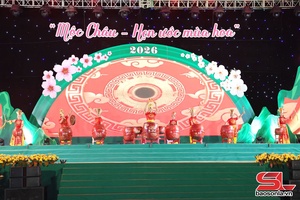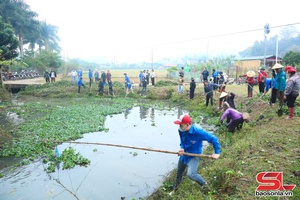

The province currently has 96 historical relic sites and scenic spots, of which 64 relic sites have been recognised, including two special national relic sites, 16 national and 46 provincial-level ones. They are diverse and cover all aspects of history - culture, landscape, art architecture, and archeology. Notably, there are 61 historical and cultural relic sites throughout the province.
Many of them have been renovated and had their value promoted such as the Son La Prison special national relic site, the special national relic site of Vietnam - Laos Revolution Historical Relic Area in Yen Chau district; the Thuan Chau Flag Tower in Thuan Chau district; the historical relic site of the resistance war against the French colonialists in Ban Nhot forest in Phu Yen district; the Co Noi intersection historical relic site and the Muong Chanh revolutionary base in Mai Son district; and the Moc Ha revolutionary base in Van Ho district; and the Resistance Zone 99 in Bac Yen district. These are "red addresses" that localities are focusing on managing and renovating to educate people, especially younger generations, about revolutionary traditions.

Ngo Thi Hai Yen, Director of the Son La provincial Museum, said that the museum is managing six relic sites, namely the Son La Prison special national relic site, the Que Lam ngu che epitaph - Temple of King Le Thai Tong, the Monument "Uncle Ho with people of northwestern ethnic groups" and Uncle Ho's Temple in Son La city; and the space showcasing cultural heritages in Son La hydropower reservoir in Muong La district. Each year, the provincial Museum welcomes over 200,000 visitors to the Son La Prison and relic sites managed by the museum.

The Son La Prison has been chosen by schools, unions and associations in the province to educate students and union members on revolutionary traditions. Each year, it organises at least 2-3 educational experience sessions along with activities to learn about figures, historical events, and local cultural heritages. It also holds activities to welcome guests to visit and learn about the prison, while coordinating with units to carry out Party and youth union admission activities for students, youth union members, and soldiers. In addition, there are also displays and exhibitions based on themes, topics, characters, and events to increase the effect of dissemination on the revolutionary history as well as the effectiveness of educational communication.

At historical relic sites, schools, youth unions and associations regularly organise “return to the roots” activities through inviting veterans to light candles to show gratitude to fallen soldiers and tell stories about history, helping younger generations understand more about local history and be proud of the nation's revolutionary traditions so as to form a noble personality.

Besides traditional activities, the management work is also being reformed, with digital technology applied to better serve the needs of people and tourists. In 2019, the provincial Museum launched the website www.baotangsonla.vn, which regularly updates information and documents, introduces programmes and activities, and promotes the image of the museum. The unit has also built the museum’s brand identity and logo, and carried out sections introducing cultural heritages, monuments, typical landscapes, traditional festivals and cultural heritage promotion activities in the province. It has also issued English - Vietnamese bilingual leaflets and brochures introducing historical - cultural relic sites and typical scenic spots of Son La; and implemented a project on the application of VR technology to build a model of visiting the Son La Prison special national relic site to widely promote the province’s cultural and historical heritages to the public.

Each relic site is associated with historical and cultural stories in each locality, serving as a reminder of the revolutionary history for today's generation. Applying information technology and digital technology is a breakthrough in promoting the value of those sites, thus bringing new, lively, and attractive experiences to students right in history lessons at schools, helping them nurture revolutionary ideals, and strive to contribute to the homeland building and safeguarding.















.jpg)
.jpg)
.jpg)


(2).jpg)

You have 500/500 characters left
Please enter 5 or more characters!!!